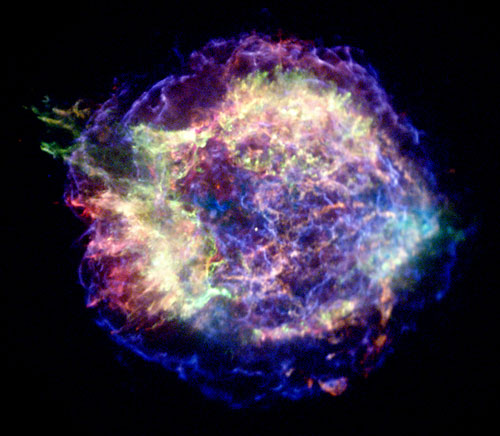Do We Live in a Giant Cosmic Bubble?

If the notion of dark energy sounds improbable, get readyfor an even more outlandish suggestion.
Earth may be trapped in an abnormal bubble of space-timethat is particularly void of matter. Scientists say this condition couldaccount for the apparent acceleration of the universe's expansion, for which darkenergy currently is the leading explanation.
Dark energy is the name given tothe hypothetical force that could be drawing all the stuff in the universeoutward at an ever-increasingrate. Current thinking is that 74 percent of the universe could be made upof this exotic dark energy, with another 21 percent being dark matter, andnormal matter comprising the remaining 5 percent.
Until now, there has been no good way to choose between darkenergy or the void explanation, but a new study outlines a potential test ofthe bubble scenario.
If we were in an unusually sparse area of the universe, thenthings could look farther away than they really are and there would be no needto rely on dark energy as an explanation for certain astronomical observations.
"If we lived in a very large under-density, then thespace-time itself wouldn?t be accelerating," said researcher TimothyClifton of Oxford University in England. "It would just be that theobservations, if interpreted in the usual way, would look like they were."
Scientists first detected the acceleration by noting that distantsupernovae seemed to be moving away from us faster than they should be. Onetype of supernova (called Type Ia) is a useful distance indicator, because theexplosions always have the same intrinsic brightness. Since light gets dimmerthe farther it travels, that means that when the supernovae appear faint to us,they are far away, and when they appear bright, they are closer in.
Breaking space news, the latest updates on rocket launches, skywatching events and more!
But if we happened to be in a portion of the universe withless matter in it than normal, then the space-time around us would be differentthan it is outside, because matter warps space-time. Light travelling fromsupernovae outside our bubble would appear dimmer, because the light woulddiverge more than we would expect once it got inside our void.
One problem with the void idea, though, is that it negates aprinciple that has reigned in astronomy for more than 450 years: namely, thatour place in the universe isn't special. When Nicholas Copernicus argued thatit made much more sense for the Earth to be revolving around the sun than viceversa, it revolutionized science. Since then, most theories have to pass theCopernican test. If they require our planet to be unique, or our position to beexalted, the ideas often seem unlikely.
"This idea that we live in a void would really be astatement that we live in a special place," Clifton told SPACE.com."The regular cosmological model is based on the idea that where we live isa typical place in the universe. This would be a contradiction to theCopernican principle."
Clifton, along with Oxford researchers Pedro G. Ferreira andKate Land, say that in coming years we may be able to distinguish between darkenergy and the void. They point to the upcoming Joint Dark Energy Mission,planned by NASA and the U.S. Department of Energy to launch in 2014 or 2015.The satellite aims to measure the expansion of the universe precisely byobserving about 2,300 supernovae.
The scientists suggest that by looking at a large number ofsupernovae in a certain region of the universe, they should be able to tellwhether the objects are really accelerating away, or if their light is merelybeing distorted in a void.
The new study will be detailed in an upcoming issue of thejournal Physical Review Letters.
- Top 10 Strangest Things in Space
- Nearby Evidence for Dark Energy
- Images: Hubble's New Views

Clara Moskowitz is a science and space writer who joined the Space.com team in 2008 and served as Assistant Managing Editor from 2011 to 2013. Clara has a bachelor's degree in astronomy and physics from Wesleyan University, and a graduate certificate in science writing from the University of California, Santa Cruz. She covers everything from astronomy to human spaceflight and once aced a NASTAR suborbital spaceflight training program for space missions. Clara is currently Associate Editor of Scientific American. To see her latest project is, follow Clara on Twitter.
